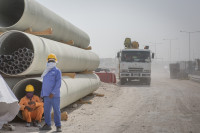Columns
Time for one class of shares
While it makes sense to necessitate promoter shares in the beginning, this should be relaxed as the market matures..jpg&w=900&height=601)
Paban Raj Pandey
The practice of dual listing of promoter and ordinary shares, particularly for banks and financial institutions, has its share of complexity in Nepal. Promoters are the ones who take the initial risk to create a company. Rules about promoter ownership are not uniform. Promoter shares of hydro companies have a lock-in period of three years post-initial public offering, after which they can be converted into ordinary shares. Banks and financial institutions, on the other hand, are subject to much stricter restrictions.
The Bank and Financial Institution Act 2017 allows banks and financial institutions to set aside at least 30 percent of their total issued capital for subscription by the general public, meaning promoters can own up to 70 percent. The Act allows promoters to sell their shares five years after the commencement of operations. After 10 years, they can, with Nepal Rastra Bank’s approval, convert their shares into ordinary. Their total ownership, however, can never drop below 51 percent. This is also true for insurance companies, except promoters can convert their shares into ordinary ones after five years.
Shares treated differently
On NEPSE (Nepal Stock Exchange), promoter and ordinary shares trade separately, with the former trading at a discount. Dual ownership is nothing new globally. But in developed markets, the concept of the founder/promoter is relevant only at the beginning. Their clout progressively wanes, particularly once a company goes public. There are a few exceptions, particularly in tech; companies ranging from Alphabet (Google) and Facebook to Alibaba and Xiaomi have dual-class share structures, where the founders are given greater voting rights than others.
In Nepal, both promoter and ordinary shares enjoy the same voting rights. They have equal claims on earnings, dividends and cash flows. The only difference between the two is how markets treat them. Promoter shares are not liquid, because not everyone is qualified to buy them. For example, the ordinary shares of Mega Bank recently traded at Rs183, even as the promoter shares were fetching Rs102. As NEPSE uses ordinary shares to calculate market capitalisation, this system pushes up the market cap.
In an ideal world, using market prices of both promoter and ordinary shares would have resulted in accurate market cap. To NEPSE’s defence, the problem is that some promoter shares may not trade for days, even weeks or months. Using old prices do not quite reflect how markets perceive what these companies are worth at any given point in time. And since banks and financial institutions and insurance companies make up such a large share of the NEPSE market cap, the distortion is meaningful.
Currently, NEPSE’s market cap is north of Rs1,400 billion. Of this, the 27 publicly listed commercial banks alone account for 68 percent. Other banks and financial institutions include 27 development banks, 20 finance companies and 50 micro-finance companies. Add to this seven life insurance and 15 non-life insurance companies. Altogether, these 146 companies account for nearly 80 percent of the total market cap.
This throws valuation metrics such as the market cap-to-GDP ratio into disarray. Currently, it shows the market as more expensive than it really is. Here, it is important to define liquidity: the ability of an asset to be converted into cash. If promoter shares are traded as liquidly as ordinary shares, the price differential will be arbitraged away. In developed markets, arbitrage routinely takes place in a whole host of assets. British Petroleum, for instance, trades on both the New York Stock Exchange and the London Stock Exchange. Arbitrageurs will swiftly take advantage of any price discrepancy that cannot be explained away by factors such as currency, taxation and government policy.
But the issue in Nepal is different. Here, we are talking about two types of shares, trading on the same exchange—one liquid, one not so. If promoter shares could be easily converted into ordinary shares, there will be an increase in supply, which at least initially, can exert downward pressure on the price. This is no music to the ears of investors who have witnessed the NEPSE index persistently head lower since peaking in July 2016 at 1888; now, it is north of 1100. But in the long run, this will add liquidity and clarity, among others.
If having one class of shares brings better clarity and gives a more accurate snapshot of market capitalisation, why have promoter shares at all? Nepal Rastra Bank argues that this is to protect the people. Banks and financial institutions are entrusted with deposit collection from the public. Before a licence is issued, it makes sure the promoters are people with credentials. If they are allowed to sell right away or as they wish, any individual or entity can end up controlling these banks. Considering the short history of NEPSE and private sector banking in the country, there is nothing wrong with this line of thought.
Budding economy
At the same time, promoters are people who have the wherewithal and willingness to take on risk. Some may want to hold on to their investments, yet others may want to move on and try their luck somewhere else. Faced with strict regulations, it is conceivable that promoters may start looking for roundabout ways to at least convert their shares into ordinary. If NEPSE’s data is anything to go by, this is not already happening, as promoters of commercial banks, for example, are shown to own at least 51 percent. Here is the rub. NEPSE’s data is not up to date. For investors, ownership—and the change in ownership—is a significant data point. NEPSE can—and should—have this data at its fingertips.
The attempt here is not to point fingers at NEPSE or Nepal Rastra Bank, for that matter. It is no rocket science that Nepal, being a budding economy, has a long way to go on reforms. The real issue is if, or how soon, policymakers are willing to rectify lapses. This is particularly important if they are serious about attracting foreign investment. Nepal Rastra Bank in this regard is probably right in not allowing promoters of banks and financial institutions to dispose of their stake freely. At the same time, it is natural for markets to expect a progressive relaxation of the ownership requirement. Promoters are already allowed to convert their shares into ordinary after 10 years, but at the same time are restricted by the 51 percent ownership requirement. Removal of the latter can begin in phases, let us say by 1 percentage point a year at first. This will pave the way for eventually having just one class of share, not to mention enhanced liquidity.
***
What do you think?
Dear reader, we’d like to hear from you. We regularly publish letters to the editor on contemporary issues or direct responses to something the Post has recently published. Please send your letters to [email protected] with "Letter to the Editor" in the subject line. Please include your name, location, and a contact address so one of our editors can reach out to you.




 17.12°C Kathmandu
17.12°C Kathmandu













%20(1).jpg&w=300&height=200)

